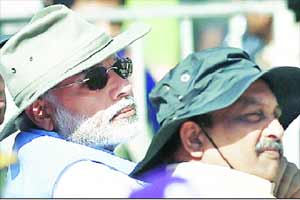Just six months after his government raised the foreign investment limit to 49% in defence production with the condition that only Indian companies will have the right to apply for such funds infusion, Prime Minister Narendra Modi has now hinted at allowing foreign majority ownership in the sector.
The move is seen to finally open the floodgates to foreign money in defence manufacturing, which is at the heart of the government’s “Make in India” strategy.
Inaugurating the 10th edition of the biennial Aero India expo here, Modi stressed that India was keen to shed the dubious reputation of being the largest importer of defence equipment and set a goal to cut defence imports from 60% now to 30% in the next five years.
He, however, indicated that a more liberal foreign investment policy would be contingent on technology transfer to the country in a big and unprecedented way. “We will build an industry that will have room for everyone — public sector, private sector and foreign firms. From sellers, foreign firms must turn into strategic partners,” he said. Defence products that are made in India will be accorded priority when it comes to procurement.
Although the government raised the foreign investment limit in the sector from 26% to 49% and said the limit would be composite one comprising foreign direct investment, foreign institutional investors, foreign portfolio investment NRIs, foreign venture capital investors and qualified foreign investors in August 2014, foreign investors have remained chary as before.
Even the statement that foreign investment above 49% would be considered by the Cabinet Committee on Security (CCS) on a case-by-case basis if state-of-the-art technology was involved cut no ice with global majors.
Modi also said the defence offset policy, which requires contractors to invest a share of the value of the deals in production in India, would be tweaked to ensure a shift from mere assembly of parts here as at present to more value-added production on Indian soil, assimilating higher and complex technologies.
“I am acutely aware that it (the offset policy) needs a lot of improvements. We will pursue them,” he said, while also expressing confidence that India would emerge as a “major global centre for the defence industry”.
However, he added that it would no longer be enough to buy equipment and simply assemble here. Apparently referring to the likes of Boeing, Lockheed Martin, Airbus and Dassault Aviation, Modi said: “We need their technology, skills, systems integration and manufacturing strength. The nature of the industry is such that imports will always be there. In turn, they can use India as part of their global supply chain.”
Stressing the huge potential for job creation in the sector, Modi said a even 20-25% decrease in imports of defence machinery would create 100,000 jobs in the country. “Our aerospace industry alone will need 200,00 people in the next 10 years,” he said.
India has imported military equipment worth several billion dollars over the past few years and is projected to spend another $250 billion over the next decade to buttress its defence preparedness. The country, with an annual defence budget of Rs 2.29 lakh crore (budget estimate for 2014-15), spends roughly 60% of this on procurement/production of capital equipment. Even as imports account for over 60% of the defence equipment added to the country’s armoury every year, FDI in the sector has so fare been paltry, not more than a few million dollars.
The prime minister highlighted the need for PSUs that dominate India’s domestic production base to improve their performance. “Frankly, our public sector needs to do much better than they are doing now. We have to exploit their huge assets and a vast potential. At the same time, we have to make them accountable.”
Aero India, a congregation where global defence majors vie with one another in showcasing their complex, state-of-the-art technologies, has over 600 exhibitors this time, 295 Indian and 328 foreign companies to be precise. In an indication of the growing the US inroads into the Indian defence industry, the US has the largest presence among foreign countries at the expo with 64 companies followed by France with 58 companies. Tata Sons, the Reliance Group, Mahindra & Mahindra and Larsen & Toubro are some of the larger domestic private-sector firms participating.
Even the statement that foreign investment above 49% would be considered by the Cabinet Committee on Security (CCS) on a case-by-case basis if state-of-the-art technology was involved cut no ice with global majors.
Modi also said the defence offset policy, which requires contractors to invest a share of the value of the deals in production in India, would be tweaked to ensure a shift from mere assembly of parts here as at present to more value-added production on Indian soil, assimilating higher and complex technologies.
“I am acutely aware that it (the offset policy) needs a lot of improvements. We will pursue them,” he said, while also expressing confidence that India would emerge as a “major global centre for the defence industry”.
However, he added that it would no longer be enough to buy equipment and simply assemble here. Apparently referring to the likes of Boeing, Lockheed Martin, Airbus and Dassault Aviation, Modi said: “We need their technology, skills, systems integration and manufacturing strength. The nature of the industry is such that imports will always be there. In turn, they can use India as part of their global supply chain.”

